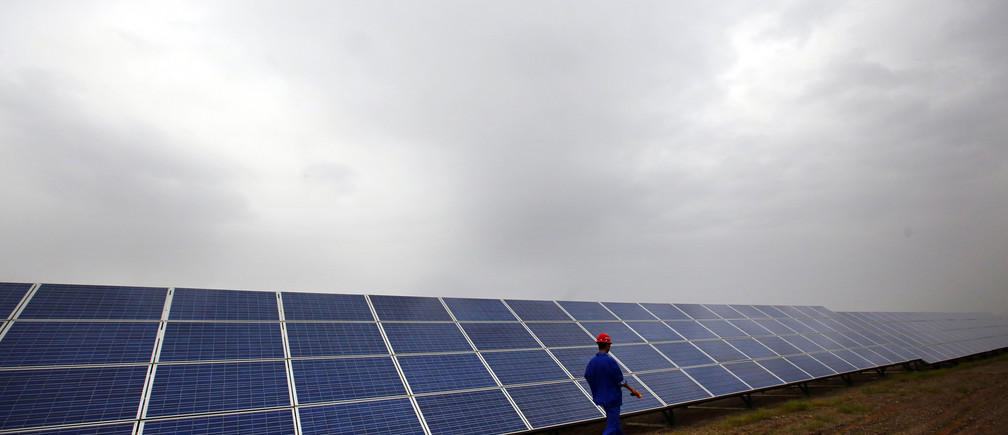China’s pollution is so bad it’s blocking sunlight from solar panels

Eclipsing the future. Image: REUTERS/Carlos Barria

Get involved with our crowdsourced digital platform to deliver impact at scale
Stay up to date:
Future of the Environment
As the world’s largest consumer of solar power, China’s energy industry is attempting to move on from its coal-burning past towards a more sustainable future. But sometimes the past isn’t easily forgotten.
New research published in the journal Nature Energy suggests the country’s densely polluted atmosphere is blocking the sun’s rays, preventing solar panels from harvesting energy efficiently.
China’s rapid economic expansion was largely fuelled by coal, which lifted millions of people out of poverty but also drove up levels of air pollution.
Led by Bart Sweerts of the Institute for Atmospheric and Climate Science in Zurich, the study mapped the effect of China’s air pollution on potential solar output from the 1960s up to 2015.
The results showed that average solar generation declined by between 11-15% over the period. Researchers forecast that a return to the air-quality levels of the 1960s could result in an increase in solar electricity harvests of more than 12%.
Costs of pollution
Economic loss is just one cost of pollution. In terms of human health, long-term exposure to toxic air increases the likelihood of strokes, lung disease, lung cancer and heart attacks.
Air pollution is the fourth-highest cause of death in the world, after smoking, high blood pressure and poor diet. According to the World Health Organization, 90% of the global population breathes air containing high levels of pollutants.
Every year, the problem contributes to more than 7 million deaths, with exposure highest in developing countries.
China has the world’s second highest number of pollution-related deaths, after India. But, as the chart above shows, Afghanistan has a higher rate of deaths per 100,000 inhabitants than any other country.
Although it is easy to imagine pollution consisting only of traffic jams, factories and smog-filled cities, many deaths are linked to the fuel used in simple countryside stoves and generators. This is the case in countries like Afghanistan, Pakistan, India, Nigeria and China, where such fatalities are high.
But China is taking steps to tackle its pollution problems.
A breath of fresh air
As far back as the 2008 Beijing Olympics, measures were put in place to improve the capital’s air quality. Heavy environmental regulation saw a 30% improvement in just one year, which resulted in a corresponding drop in cardio and respiratory disease among Beijing residents.
In 2013, China set about cleaning up the air quality of its cities. The sources of air pollution and toxic rain were identified, which included traffic and factory emissions as well as the practice of straw burning on farms.
Strong enforcement and better regulation led to factories relocating away from populated areas, while some heavy-polluting plants were closed. To prevent farmers burning straw, they were given government subsidies to encourage them to recycle it instead.
But China relies heavily on manufacturing, and the cost of suspending production and relocating or shutting down companies can be high. A similar problem exists in many developing countries faced with balancing income, growth and the population’s health.
China’s solution is to channel new infrastructure investment into renewable energy technologies. While International Energy Agency data shows that coal accounted for approximately 60% of China’s energy mix in 2016, compared to just 5% for solar power, things are changing.
The future lies in diversifying China's energy landscape into clean energy-generating sources like solar power, wind farms, hydro and bio-energy. The country is already a world leader in solar power capacity, a market that is predicted to grow to double that of the US by 2024.
While coal continues to play a key role in the country’s energy landscape, it is set to fall from two-thirds of the total power mix today to just 40% by 2040.
A recent McKinsey report predicts that fossil fuels such as oil and gas will continue to dominate the world’s energy use through to 2050. While renewable technologies are set to grow by four to five times faster than other power sources.
A cleaner energy mix bodes well for China’s long-term air quality, as it will allow the burgeoning solar sector to harness sunshine more efficiently. The country has achieved a lot in its fight against pollution, but there is still a long way to go.
Don't miss any update on this topic
Create a free account and access your personalized content collection with our latest publications and analyses.
License and Republishing
World Economic Forum articles may be republished in accordance with the Creative Commons Attribution-NonCommercial-NoDerivatives 4.0 International Public License, and in accordance with our Terms of Use.
The views expressed in this article are those of the author alone and not the World Economic Forum.
The Agenda Weekly
A weekly update of the most important issues driving the global agenda
You can unsubscribe at any time using the link in our emails. For more details, review our privacy policy.
More on Nature and BiodiversitySee all
Lisa Donahue and Vance Scott
April 28, 2024
Dan Lambe
April 24, 2024
Roman Vakulchuk
April 24, 2024
Charlotte Kaiser
April 23, 2024
Jennifer Holmgren
April 23, 2024









